Archives of Animal & Poultry Sciences - Juniper Publishers
Abstract
Gross and histological morphology and biometry of two muscles of flight were studied, 5 local Nigerian chickens, 5 broilers and 5 pigeons, were purchased from Sokoto meat market. Each of the birds were weighed, bled, their skin was dissected to expose and extract their flight muscle [supracoracoideus and pectoralis]. Biometrics of the muscles were obtained using a ruler, tape rule and measuring scale. The relative muscle weight was 9.41%, 11.60% and 21.20% in broiler, local chickens and pigeons respectively. Flight muscles in pigeon also appeared darker in color with numerous nuclei and mitochondria compared to broilers and local chickens, these justifies why pigeons could fly higher than broilers and local chickens.
Keywords: Local Chicken; Broiler; Pectoralis; Pigeon; Supracoracoideus
Introduction
Birds [Aves] are group of endothermic vertebrates, characterized by high metabolic rate, feathers, toothless beaked jaws, hard-shelled eggs, a strong and lightweight skeleton Barnard et al. [1]. Birds serves as sources of income and protein, they live worldwide and range in sizes and colors, and they are world’s most numerically successful class of tetrapods with about ten thousand living species Stakebake [2]. Birds have wings and the species determines its level of development. The forelimbs forms wings which give birds the ability to fly Biewener [3]. The respiratory and digestive system of birds are also adapted for flight Eckmeier et al. [4]. The upstroke and downstroke movement of bird’s wings is controlled by the activity of bilaterally symmetrical muscle pairs [pectoralis and supracoracoideus] Baume [5]. The supracoracoideus is the second largest wing muscle in birds [Eckmeier et al., 2008]. It is the major antagonist to the pectoralis, which is the primary downstroke muscle for flight Baume [5].
Across the world, several studies have been conducted on the flight muscles in birds such albatrosses, sparrow and guinea fowl Meyers, Jennifer & Nassar et al., [2,6,7]. However, there is dearth of information regarding gross and histology of the flight muscles in Nigerian local chicken, broilers and pigeons found in Sokoto and Nigeria at large. This work is generally aimed to examine the gross and histological features of pectoralis and supracoracoideus muscles in domestic fowl [Broiler and local domestic chicken in Sokoto] and Pigeon in relation to flight. Providing information about pectoralis and supracoracoidieus muscles in various avian species will enrich the literature on their gross and histological features. This information helps the anatomist to know much about the reason behind the action of pectoralis and supracoracoideus muscles in some avian species. This information helps in knowing how deep a needle should go in administering drugs intramuscularly in some avian species. The result obtained will helps in diagnosing problems associated with bird’s flight by clinician, it will also provide the information about the effect of domestication on flight muscles in avian species and helps to determine the effect of genetic modification on flight muscles.
Material and Methods
A total number of 15 healthy adult birds [5 Nigerian local chickens/Fulani ecotypes, 5 broilers and 5 pigeons] were purposively sampled and purchased from Sokoto meat market. The birds were transported in a ventilated cage to the Department of Veterinary Anatomy Laboratory Usmanu Danfodiyo University Sokoto. Each of the birds were weighed [using a weighing scale], bled by severing their jugular veins and defeathered.
The birds were dissected on a dorsal recumbency, using a pair of scissors to incise the keel region so as to expose the pectoralis and supracoracoideus muscles, with the aid of a scalpel blade, the two muscles were detached from their point of origin [body of the sternum] and insertion [keel bone]. The two muscles were studied grossly to observe their color differences and their photographs were captured using a digital camera. Furthermore, with the aid of a ruler, measuring tape and weighing balance, the following morphometric parameters were measured:
a) Muscle length [ML]: was measured from the anterior to the posterior border of each of the pectoralis and supracoracoideus using a ruler
b) Muscle width [MWi]: was measured from the lateral to medial borders along the mid portions of each of the pectoralis and supracoracoideus using a tape rule.
c) Muscle weight [MWe]: was measured using a weighing scale.
Tissue samples were taken from the middle parts of the pectoralis and supracoracoideus muscles and fixed in Bouin’s solution, sections were prepared using H and E routine histological techniques. Morphometry software package; ImageJ [1.50e version] was used to determine the number of muscle cell nucleus per 5.29 area (Table 1) and a descriptive statistical analytical tool were used to analyzed data generated from these studies

Result
Pectoralis muscles
In local and broiler chickens, pectoralis appeared pale in color, elongated and complex, while in pigeons it appeared dark red in color, broad and also complex (Plate 1). In the three birds, pectoralis covers the entire ventral surface of the chest region. It originates from the lateral and caudal surfaces of the sternal body, the lateral surfaces of the furcular and from adjacent membranes. The pectoralis inserts on the ventral surface of the pectoral crest of the humerus by an internal aponeurosis. In the domestic fowl [local and broiler chickens] the pectoralis was divided inti two distinct parts [sternobrachialis and thoracobrachialis] by an internal sheet of connective tissue.
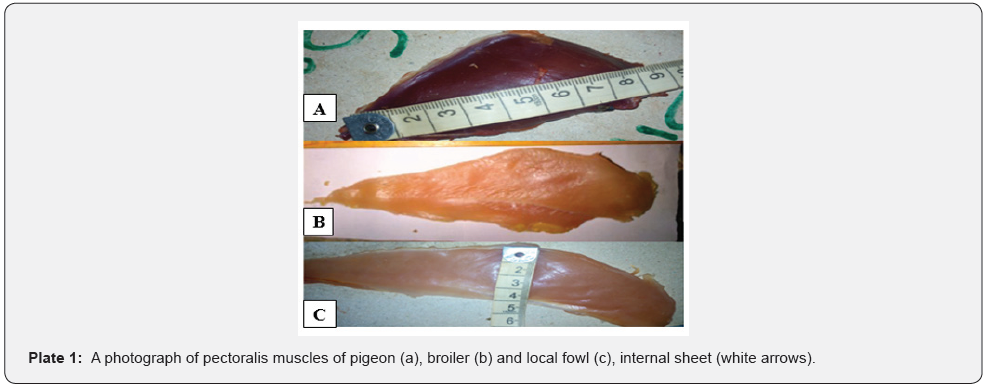
Supracoracoideus muscles
This muscle appeared pale in local and broiler chickens and dark colored in pigeons. in all the birds, supracoracoideus appeared fusiform in shape (Plate 2) and deeply related to the pectoralis on the ventral surface of the body. The muscle originates from the sternal body and keel and inserted on the dorsal tubercle of the humorous by means of a tendon (Table 2 & 3).
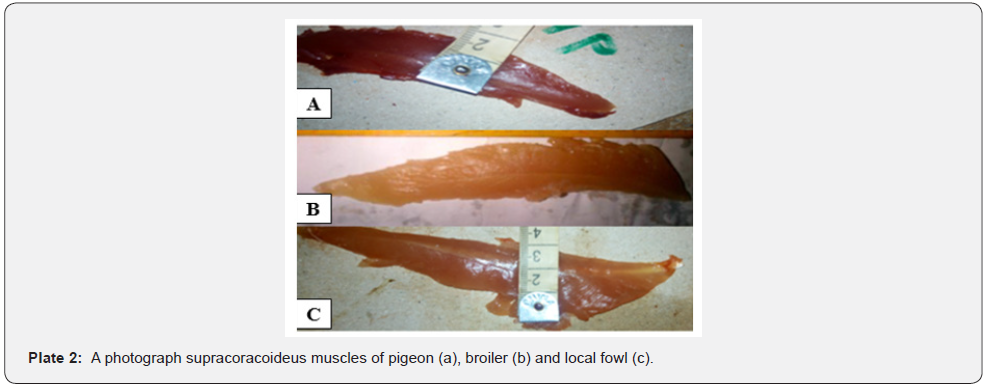
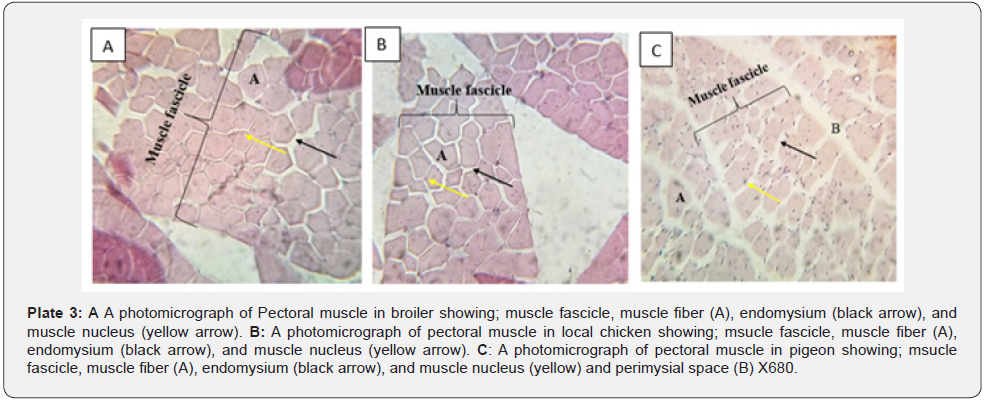


The relative weight of the pectoralis muscle of local chicken, broiler and pigeon were 6%, 6.75% and 18% respectively while the relative weight of the supracoracoideus muscle of the local chicken, broiler and pigeon were 3%, 2.66% and 4% respectively (Plate 3 & 4) (Graph 1).
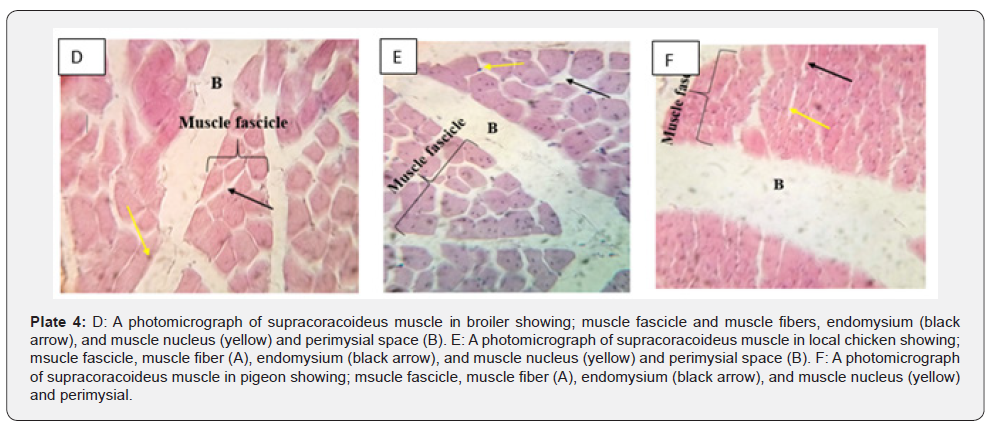
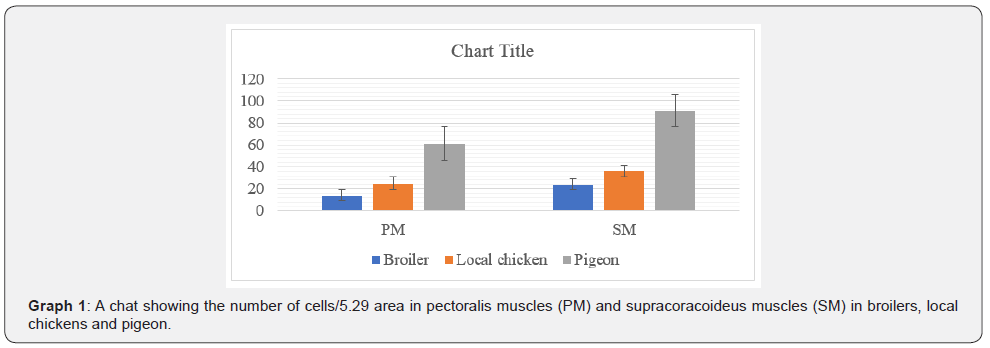
Discussion
The origin of the pectoralis muscle was generally observed to be similar in all the three studied birds. This findings is in line with the report of Biewener [8] in pigeon, who reported that the main portion of pectoralis [sternobrachialis] originates from an enlarged sternal keel with more anterior fibers arising from furcular, a much smaller portion [thoracobrachialis] originates dorsally from the ribs. The origin of the flight muscles in this study agrees with the findings of George [9], who reported that pectoralis in pigeons originates dorsally from an enlarged sternal keel with more anterior fibers arising from the furcular, and a much smaller portion originates dorsally from the ribs. The point of insertion of pectoralis muscle in this study also agrees with the findings of Wada & Dial [10,11] in pigeon and domestic fowl who reported that pectoralis muscle inserts on the ventral surface of the humerus. The origin and insertion of supracoracoideus muscle in this study is similar to the findings of Wada et al., [10]. The color and shape of pectoralis and supracoracoideus in this study were in agreement with the report of Kiessling [12], who reported that the flight muscles of pigeon were reddish in color while those of the domestic fowls were white in color.
The mean weight, length, and width of pectoralis and supracoracoideus muscles were observed to be significantly higher in local chicken, followed by broilers and then pigeon except for the width, where the broiler is significantly higher than in local chicken [P≤0.05]. The relative weight of the pectoralis in pigeon [18%], was contrary to the findings of Sokoloff et al, [13] who reported that pectoralis is a large muscle of approximately 8-11% body weight. The difference might be due to the difference in breeds used in the study. George & Berger [14] reported as found in this study that, the size of the flight muscles in a bird is related to its flying ability. In the birds that are powerful fliers, over 20% of the birds’ weight is flight muscle. In birds that do not fly, less than 10% of the birds’ weight comes from the flight muscles. In the present study, 21.20% of the pigeon weight is flight muscle, indicating that the pigeon is a powerful flier, while 9.41% of the broiler weight is a flight muscle, indicating that the broiler is not a powerful flier (Plate 3 & 4).
The histological studies of both pectoral and Supracoracodeus muscles showed that the perimysial space in pigeon is wider than that of broiler and local chickens, similarly, the number of muscle nuclei in pigeon is more compared to that of broiler and local chicken and this is due to the larger numbers of muscle fibers present in pigeon. Each muscle fiber [muscle cells] contains all the organelles that are found in other types of cells including mitochondria, mitochondria produces energy that is required for muscle contraction to enable movement and flight Hood [15]. Hence, the dark red pectoral and supracoracoideus muscles observed in this study is due to the numerous numbers of muscle fibers observed from our histological findings and this further explains why pigeon could fly higher than broiler and local chicken Mishra et al. [16].
Conclusion
Since 21.20% of the pigeon weight was flight muscle and its flight muscles also appeared darker in color with numerous nuclei and mitochondria, these indicated that the pigeon is a powerful flier than broiler and local fowl. Also, with 9.41% of the broiler weight was the flight muscle; it indicated that the broiler is not a powerful flier. Furthermore, this work probably was the first comparative study on the flight muscles of domestic fowl, broiler and pigeon, thus it has established a baseline data for the pectoralis and supracoracoideus muscles in domestic fowl, broiler and pigeon. It is expected that the result will guide further researches on the determination of flying ability in different species of birds.
To Know more about Archives of Animal & Poultry Sciences
Click here: https://juniperpublishers.com/index.php
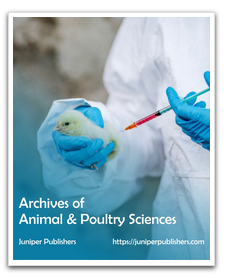




No comments:
Post a Comment